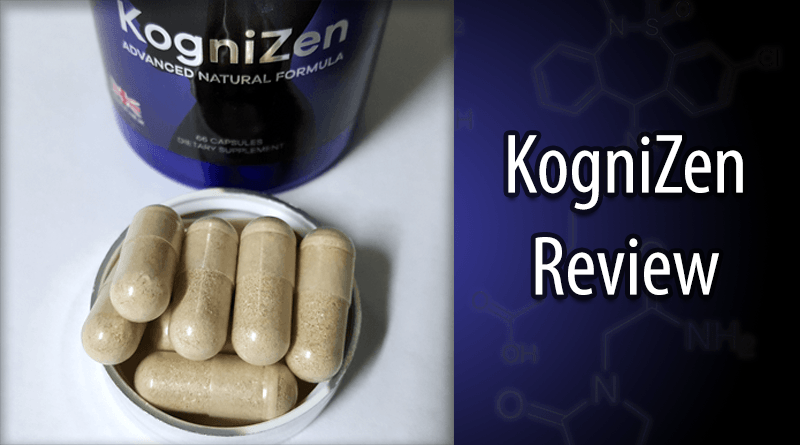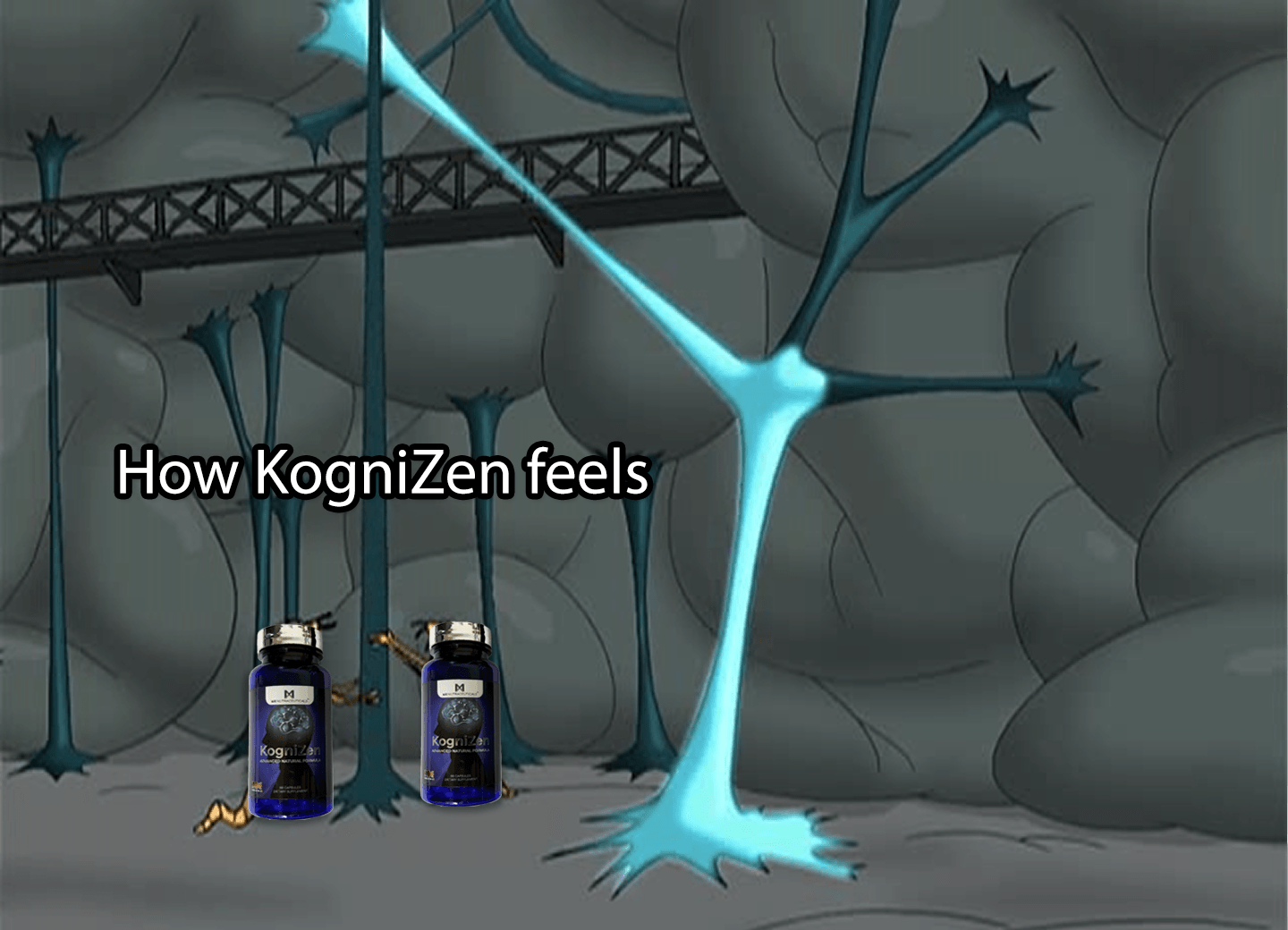Last updated on February 27th, 2020 at 09:50 pm
KogniZen is nootropic formula designed to enhance focus, mood, energy, and memory. It includes 6 natural nootropics and 5 b-vitamins. From the research I’ve seen, each individual nootropic in KogniZen is synergistic with at least one of the other nootropics. An example is Caffeine + L-Theanine, which is a classic nootropic combination that many people find synergistic.
Another is Ginseng + Ginkgo, which has a lot of research backing it up. Moreover, the b-vitamins should ensure that neurotransmitter production is optimal. Thus they should reduce any bottlenecks to KogniZen’s effects.
Before even taking it I suspect I’ll get a bit overstimulated given the high caffeine content in each serving. At 150 mg, that’s 1.5 cups of coffee. This alone shouldn’t really be too stimulating but in combination with the other nootropics I’m a bit worried that I’ll end up with too much energy.
Regardless, this combination of nootropics is something I haven’t seen before so I’m a bit excited about it. KogniZen uses appropriate doses for each nootropic. Typically, many so called ‘nootropic’ formulas include only small doses of the nootropics in favor of high-dosing the most noticeable ingredient, usually caffeine. They do this to give their product more of a kick rather than actual cognitive benefits.
Update: You may have noticed that the KogniZen site no longer loads. Sadly, it appears that KogniZen is no longer being produced. I spoke with the owner and he just wasn’t making enough money for it to be viable. What a shame, the KogniZen formula was solid.
Disclosure: I received this product for free to review, but it has no influence on my rating.
Anyway, in this review I will be looking at:
- What benefits KogniZen gives me
- Science and research behind the Nootropics
- Packaging quality
- Safety
- Ingredients
- Consistency of capsules
Table of Contents
Summary
| Pros | Cons |
|---|---|
| Includes synergistic nootropics – Each nootropic in this formula is synergistic with at least 1 of the other nootropics | Uses folic acid instead of methylfolate – Some people can’t process folic acid due to what’s called an MTHFR mutation. Methylfolate is the active form of Vitamin B9 and it’s odd that it wasn’t include given how the Vitamin B6 is in its active form, P5P. |
| Greatly improves mood – I found KogniZen to uplift my mood in a rather strong manner. Its mood-lifting effects are even greater than that of Adderall | Poor safety seal – The safety seal on the bottle opening was loose and wasn’t even sealed in some areas. |
| Enhances energy but doesn’t increase it – It’s like it increases my energy reserves so that I have more energy when I need it. But at the same time it doesn’t make me feel over-energized | Decreases fatigue too well – In addition to enhancing energy it noticeably decreases fatigue. But it does this too well. It significantly worsened my sleep quality because I simply didn’t feel sleepy before bed |
| Enhances focus – As with energy, KogniZen enhances my focus but doesn’t increase it. Meaning it works its magic in the background and doesn’t give off that artificial, forced focus that stimulants do. | Dusty insides – The insides of the bottle are covered in what I assume is nootropic dust that leaked from the capsules. It gives the product a rather cheap feel. |
| Safe and pure ingredients – I checked out KogniZen’s certificates of analysis and it appears everything is good. The nootropics are pure, free from heavy metals and free from bacteria. | |
| Consistent capsules – I weighed 10 capsules on my digital scale and they were all within the error margin |
Effects
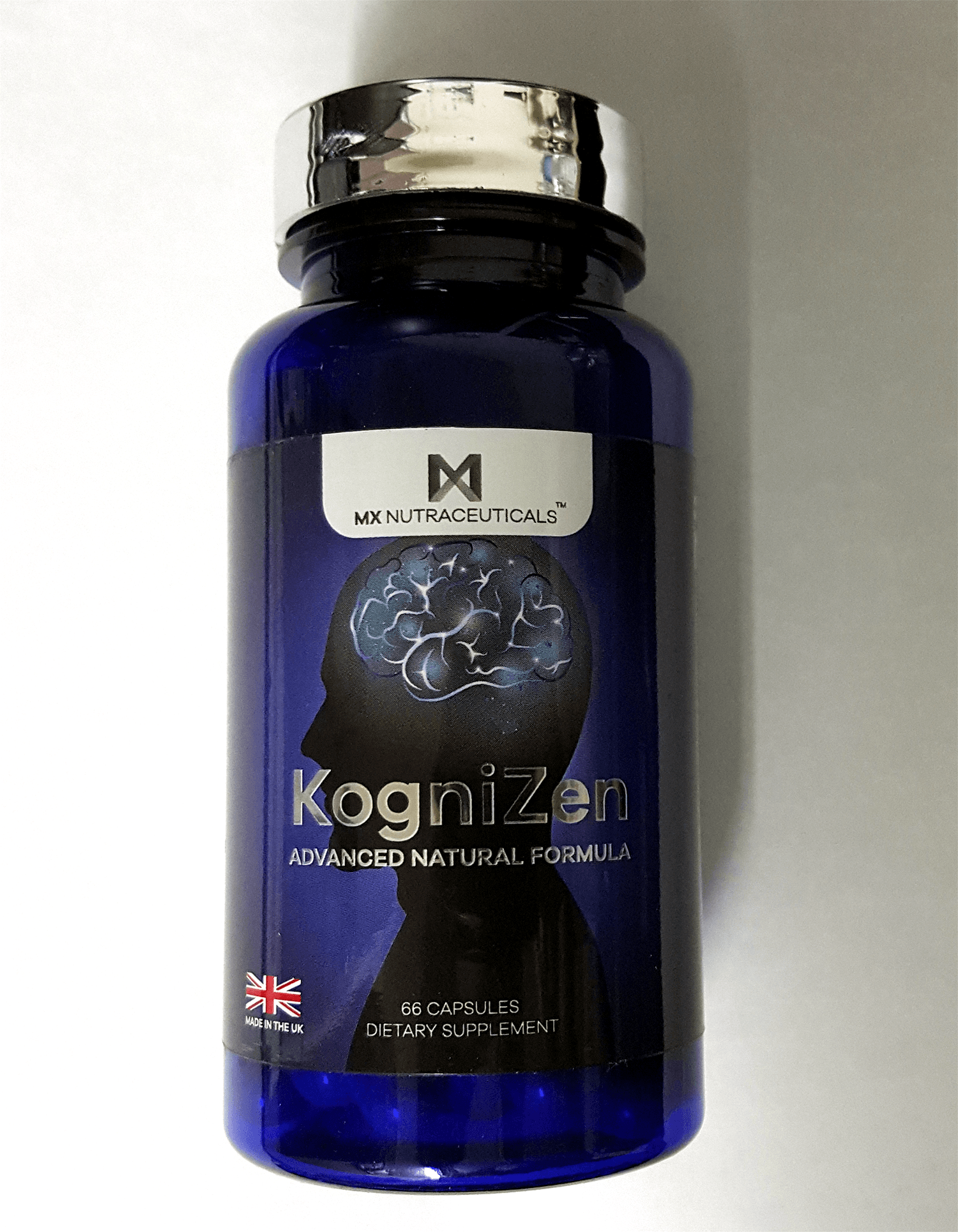
Within 30 minutes of taking it I began to feel almost like I was on a pharmaceutical stimulant with a benzo added in. Having taken amphetamine is the form of Adderall, Dexedrine, Vyvanse, as well as various forms of methylphenidate and modafinil, I’m well aware of how stimulants make me feel. And KogniZen is surprisingly a lot like dexedrine, which is the brand name for dextroamphetamine.
The effects are unmistakable, whenever I take dexedrine I get a pronounced mood-lift, a nice relaxing bodily sensation, and a noticeable increase in both mental and physical energy. Not to mention the improved focus. However, dexedrine also makes me jittery, and the relaxing sensation only lasts a few minutes before tension quickly takes its place.
KogniZen not only seems to give me the positive effects of dexedrine, but it does so without any tension. Though, the effects are definitely milder compared to dexedrine.
Regardless, the effects are longer-lasting, more stable, and less distracting. Stimulants typically make me feel like I’m on a drug and this is a subtle distraction. But KogniZen feels natural, smooth, gentle.
In other words, stimulants almost force me to become more focused and energized, as though the regular non-stimulant me has been temporarily blocked from having a conscious influence on my actions. KogniZen, on the other hand, seems to make going with the flow much easier. There’s less resistance when engaging in demanding cognitive tasks.
In terms of how strong each effect is, this is how I would rank them:
- Mood – Most noticeable effect. A very clear uplifting effect that makes me feel chilled, relaxed, but not lazy.
- Energy – A subtle increase in energy reserves. Baseline energy is more or less the same, but there’s more energy when I need it.
- Focus – Same thing with energy, a subtle enhancement.
- Memory – Subtle improvement in short-term memory
Here’s how KogniZen affects me relative to my baseline level of how well I feel in each factor:
Focus
I have to say when I felt it starting to work I didn’t think it had much of an effect on my focus. Honestly, at first it made it worse because I became too relaxed. But when I got used to the relaxation I found my focus to be more or less at baseline.
So it didn’t seem to have much of an effect. That is until I started doing work. And that’s when I realized this nootropic formula doesn’t increase focus, but rather enhances it.
The difference being increased focus is something you feel all the time regardless of whether you’re doing something cognitively-demanding or not. Whereas enhanced focus only occurs when you really want to focus. The former is part of the reason stimulants make me feel like I’ve taken a drug. The focus is unnatural, intense, and forced. But KogniZen doesn’t force anything.
It seems that it only enhances focus when there’s an intention for focus to improve. So when doing work there’s a subconscious intention to focus in on the work. But there’s usually some resistance before the mind calms down and goes with the flow.
On KogniZen, I didn’t feel any resistance, in fact I didn’t even notice that I had no resistance until I realized I was already in a flow state within minutes of starting to do work.
Mood
As mentioned earlier, this nootropic formula gives off an amphetamine-like effect. The mood change is by far the most noticeable effect. However, at the same time it’s subtle. It’s a weird combination, but it works well.
Rather than just uplifting mood, KogniZen seems to eliminate any worries, anxieties, and anything that stresses the mind. Basically, it enhances mood by temporarily breaking the chains of suffering.
Another thing I noticed is that any positive states of mind are intensified, but not so much so that it starts becoming a distraction. Rather, it changes things in the background, or the subconscious mind.
And this is the most optimal thing for productivity as it leaves the conscious mind free to focus in on whatever it wants.
One odd thing I’ve noticed is that my mood slowly continues improving as opposed to stimulants that give an immediate mood-lift and run away shortly thereafter. It’s almost like KogniZen becomes a companion in the background that continues to slowly boost mood in a gentle and natural way.
In short, it truly does put me in a zen-like state.
Energy
Energy is something that I lack a lot, both physically and mentally. Most of the time I feel fatigued and even stimulants like caffeine have little to no effect. But KogniZen is different. It doesn’t seem to increase energy but rather increases energy reserves.
The difference being is that increased energy reserves means there’s more energy when you need it vs increased energy being present at all times. In other words, it improves natural energy without causing agitation from being over-energized.
Furthermore, I found myself being able to stay productive for longer periods of time without a noticeable decrease in energy. So it seems to decrease energy expenditure.
Also, because it improves mood, work becomes almost like play and thus requires a lot less energy to engage in. Not only that, but positive states of mind can self-sustain themselves by causing a positive feedback loop. When you feel joy, joy automatically increases and keeps on increasing until something negative comes along.
- Increasing energy reserves
- Reducing energy expenditure
- Improving mood thereby causing a positive feedback loop
Memory
Given how it’s supposed to be cycled on a 5 day on, 2 days off basis I didn’t think there would be any noticeable improvement in memory. Most nootropics that improve memory only do so after chronic dosing, usually 2 weeks or more.
However, I didn’t account for other factors like mood and energy. Indeed, the better the mood the better the memory. When we are happy our brains work better. Also, a lack of energy can impair memory.
With KogniZen there wasn’t as strong of an effect on memory as there was on mood, energy and focus, but it was there nonetheless. Things like remembering important tasks, important times, and other short-term memory factors felt improved.
Sleep
I honestly didn’t think I would need to write anything about its effects on sleep as very few substances affect my sleep. Stimulants like Dexedrine, Adderall, and Methylphenidate make it harder for me to fall asleep, and sleep quality is definitely reduced by them but at the same time they don’t cause me to drift in and out of consciousness multiple times during sleep.
This is where KogniZen differs from them. Not only do I find falling asleep much, much harder, but the quality of sleep drastically decreases.
On stimulants, it’s a matter of having too much energy, but the feeling of sleepiness is still there. However, on KogniZen, there is no issue of too much energy, rather sleepiness itself is almost completely missing.
I simply don’t feel tired before bed. I don’t feel tired in bed, and even when I do manage to fall asleep I wake up at least once every hour and still don’t feel tired. Normally I’m dead tired if I wake up during my sleep. I would feel intense drowsiness and fatigue.
KogniZen has managed to completely rid me of these states of mind. I attribute this to its fatigue-reducing effects. It’s not a matter of too much energy, but not enough fatigue.
I’m not sure what nootropic or combination of nootropics causes this, but it’s definitely not the caffeine. I can drink a ton of coffee and still sleep fine. After all, caffeine has a half-life of 5 hours or so and it’s hard to not notice that it’s out of my system.
Nootropics
| Nootropic | Benefits | Dosage in studies | Dosage in 1 serving of KogniZen | Notes |
|---|---|---|---|---|
| L-Theanine |
| 100 mg - 250 mg | 300 mg | Highly synergistic with caffeine |
| Caffeine |
| 40 mg - 200 mg | 150 mg | Highly synergistic with L-Theanine |
| Ginkgo Biloba |
| 60 mg - 360 mg | 180 mg | Highly synergistic with Ginseng |
| Ashwagandha Root |
| 125 mg - 500 mg | 450 mg | May increase testosterone with chronic doses |
| Korean Panax Ginseng |
| 100 mg - 400 mg | 360 mg | Highly synergistic with Ginkgo |
| Rhodiola Rosea |
| 100 mg - 600 mg | 435 mg | |
| Vitamin B1 - Thiamine | May have cholinergic properties which can potentially improve memory and learning | 50 mg | 9 mg | |
| Vitamin B3 - Niacin | Enhances levels of BH4, a co-factor in the production of the neurotransmitters dopamine and serotonin | N/A | 9 mg | |
| Vitamin B6 - Pyridoxal-5-Phosphate | Aids in the production of dopamine | N/A | 6 mg | |
| Vitamin B9 - Folic Acid | Enhances methylation and increases BH4 levels | 400 mcg - 5 mg | 300 mcg | Some people don't react well to folic acid due to an MTHFR mutation |
| Vitamin B12 - Methylcobalamin | Recycles homocysteine back into SAM-e, which is involved in the production of dopamine, serotonin and noradrenaline | N/A | 100 mcg |
L-Theanine
L-Theanine is an amino acid found naturally in tea, particularly green tea. It’s what gives tea its soothing and relaxing effects.
It increases GABA, dopamine, serotonin, and glycine in the brain. GABA is a neurotransmitter that promotes relaxation, but also sedation. However, because L-Theanine also increases other neurotransmitters, there is a sort of balance between them and the result is relaxed alertness. As a result, it can effectively reduce stress under otherwise stressful situations.[1]
Because of this, L-Theanine has been described as Zen in a pill.
One astounding thing about it is that it increases alpha brain waves, the same type of waves meditation increases.[2] This boosts creativity, reduces depression, and promotes alert relaxation.
Caffeine
Caffeine is familiar to almost everyone. It improves energy, mood, focus, memory, and more. But, it typically causes jitters and this is especially true in high doses.
However, combining caffeine with L-Theanine results in a synergistic effect which not only multiplies their nootropic benefits, but also cancels out caffeine’s negative effects.
Many studies have shown that this combination not only improves cognition but also mood.[3][4][5][6]
Ginkgo Biloba
Ginkgo is a well-known herb that’s been used for a myriad of different conditions. It can improve memory, attention, mood, reduce fatigue, improve blood circulation, and has many more benefits.[7]
Did you know that Ginkgo trees survived the hiroshima nuclear bombings? It’s true, they are very resilient to death and can even live up to 3500 years.[8]
Ginkgo alone can improve attention and memory, but combined with Ginseng there’s a significant synergistic nootropic effect.[9][10][11]
Ashwagandha Root
Ashwagandha, also known as Withania somnifera, is known as an adaptogenic herb. In short, it helps the body to adapt to stress.[12]
The main benefit of Ashwagandha is that it can reduce anxiety. It does this by increasing GABA-A activity. This is the same receptor that benzodiazepines act on, but ashwagandha does it in a much safer way.
Benzodiazepines are notorious for causing dependence and tolerance. Not only does ashwagandha not cause dependence and tolerance, but its anxiolytic effect increases after chronic dosing.
Moreover, it doesn’t just make you feel like you’re less stressed, but it actually lowers cortisol, C-Reactive Protein, heartrate, and even blood pressure. It can also increase a hormone known as DHEA-S, which has been touted as the hormone of youth.[13]
Increased DHEA-S levels can improve memory, attention, and other cognitive factors. There’s a correlation between the DHEA/cortisol ratio and cognitive performance, with higher levels showing greater cognitive performance.[14]
Korean Panax Ginseng
Ginseng has been used for thousands of years for all kinds of different conditions. As a nootropic, it improves attention, energy, reduces fatigue, and mood.[15][16][17][18]
As mentioned above, Ginseng combines well with Ginkgo to create a synergistic nootropic effect that further improves memory and attention.
Rhodiola Rosea
An adaptogenic herb, Rhodiola is well-known for its ability to reduce stress, fatigue, anxiety, improve focus, mood, and memory.[19][20] It also seems to increase general well-being. I have used Rhodiola extensively and I’m quite familiar with its effects.
However, Rhodiola is one of those herbs where the brand really matters. It’s typically standardized to Rosavins and/or Salidrosides, most commonly as 3% and 1%, respectively. And even this doesn’t really seem to matter all that much because different brands standardized to the same active ingredients always seem to differ in their effects.
Personally, I’ve found only a few brands to elicit optimal effects. These are Nootropics Depot’s and Eclectic Institutes’s Rhodiola. And despite their high quality, their effects still differ a bit.
That said, I have tried many different brands ranging from very poor quality to excellent quality. If I had to rate the Rhodiola in this formula, I’d say it’s good but not excellent. However, its effect are likely being affected by the other nootropics. So take it with a grain of salt.
Vitamin B1 – Thiamine
Thiamine is an essential vitamin and most people get enough to prevent deficiency. But it may be helpful to supplement it.
Thiamine supplementation at 50 mg for 2 months was able to improve clearheadedness, composure, and energy in a study involving oddly only females.[21]
High-doses may also have cholinergic effects which can potentially improve memory, learning, and cognition.[22]
Vitamin B3 – Niacin
Niacin is another essential vitamin that supports neurotransmitter production. Once in the body, niacin gets converted into a compound known as NADH. And NADH stimulates dopamine biosynthesis by increasing tetrahydrobiopterin levels, also known as BH4. It does this by improving recycling of this compound.[23]
Also, BH4 is directly increased by methylfolate, the active form of folic acid, and methylcobalamin aids in this regard.
Vitamin B6 – Pyridoxal-5-Phosphate
Vitamin B6 is essential for the production of dopamine. In one of the many steps leading to dopamine being produced, L-DOPA is made, which is a precursor to dopamine. However, for it to be converted into dopamine requires the use of Vitamin B6.[24]
The Vitamin B6 in this formula is in the active form, also known as P5P. In high doses, Vitamin B6 can cause neuropathy, but that’s only if it’s taken in its inactive form, pyridoxine. P5P is devoid of this side effect. Not only that, but it has a higher bioavailability.
Vitamin B9 – Folic Acid
Folic acid is a standard vitamin but I don’t like that it’s included in this nootropic formula. It is inactive and needs to be converted in the body into its active form. But, about 1/3 of the population can’t process it. They have what is called an MTHFR mutation.[25]
This prevents their bodies from processing folic acid efficiently and can in turn cause all kinds of problems.
Methylfolate is the active form of Vitamin B9 and given how both the Vitamin B6 and Vitamin B12 in this formula come in their active forms I’m surprised to see the inactive folic acid being used.
That said, methylfolate is essential for the production of neurotransmitters, particularly dopamine, serotonin, and norepinephrine.[26][27][28]
Vitamin B12 – Methylcobalamin
Vitamin B12 is essential for red blood cell production, energy utilization, and methylation. In the case of cognition, it’s mainly methylation that gives B12 its nootropic effects.
A molecule in the body known as SAM-e, short for S-Adenosylmethionine, is essential in the methylation cycle. SAM-e is involved in the production of neurotransmitters dopamine, serotonin and norepinephrine.[29]
However, once SAM-e is used it gets converted into homocysteine, an amino acid that’s regarded as being undesirable. This is because homocysteine can increase inflammation, increase blood clots, and even increase the risk of heart attacks and strokes.
This is where Vitamin B12 comes in. It converts homocysteine back into SAM-e.[30]
In short, Vitamin B12 can directly increase SAM-e levels in the body.
Packaging
The bottle KogniZen comes in is nothing special. It’s a pretty standard plastic bottle. It has a blue tint and is a bit transparent.
But, it has no quick-access lid. You need to unscrew the entire lid to get the capsules. It’s not a big deal, but it’s rather inconvenient.
Aside from that, the bottle had no plastic seal. Again, not a big deal but it’s more assuring if it was double-sealed. This is the standard in the supplement industry – a plastic wrapper on the outside of the bottle and a tight aluminium seal on the opening of the bottle.
KogniZen only comes with an aluminium seal on the opening of the bottle. Speaking of which, when I first opened the bottle a part of the bottle cap was stuck to the seal. I assume it’s some kind of moisture absorbent material.
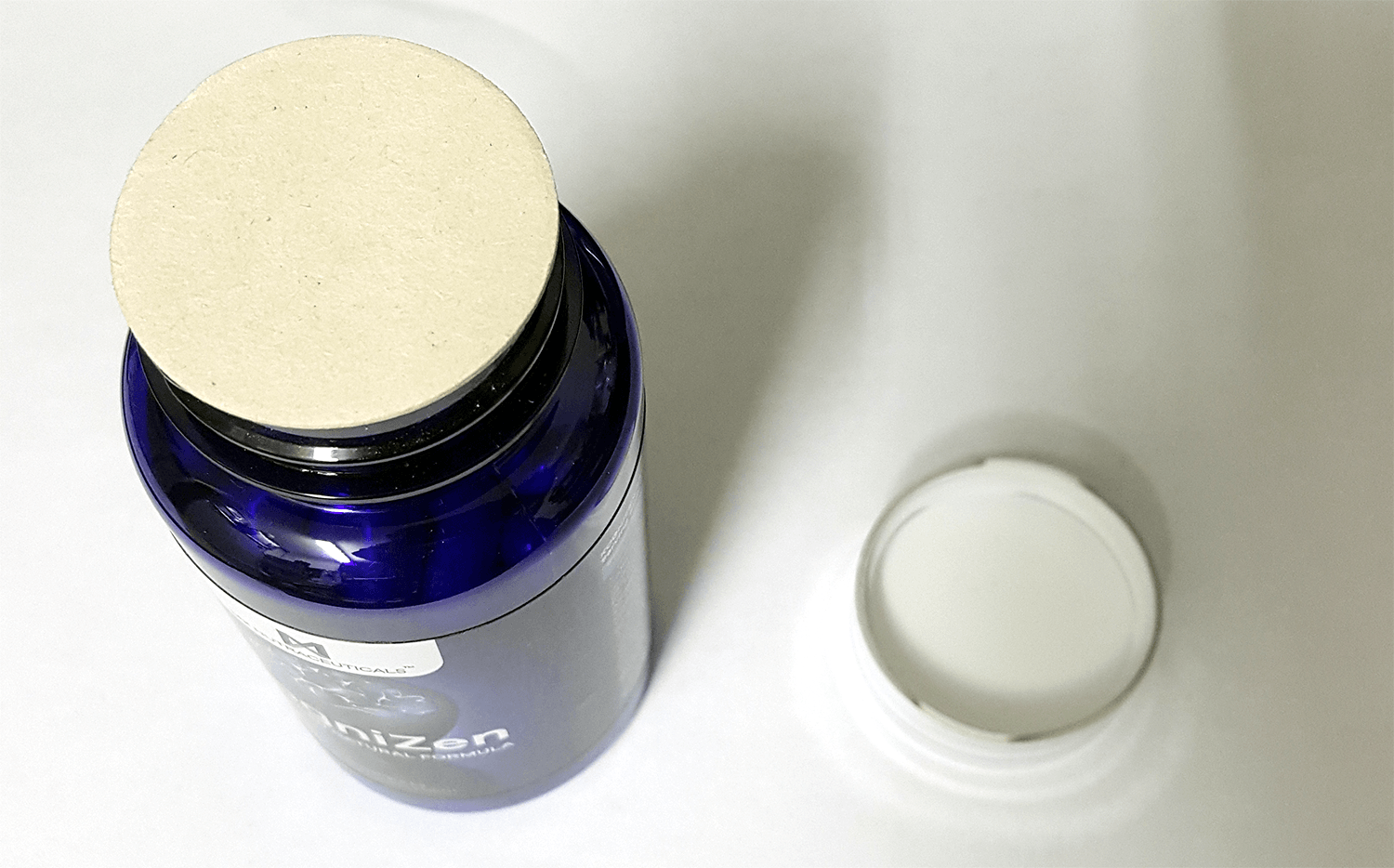
It left a mark on the aluminium seal. Which brings me to my next point, the aluminium seal was not only flimsy, but loose. Some parts of the bottle opening were not even sealed, which is rather worrying.
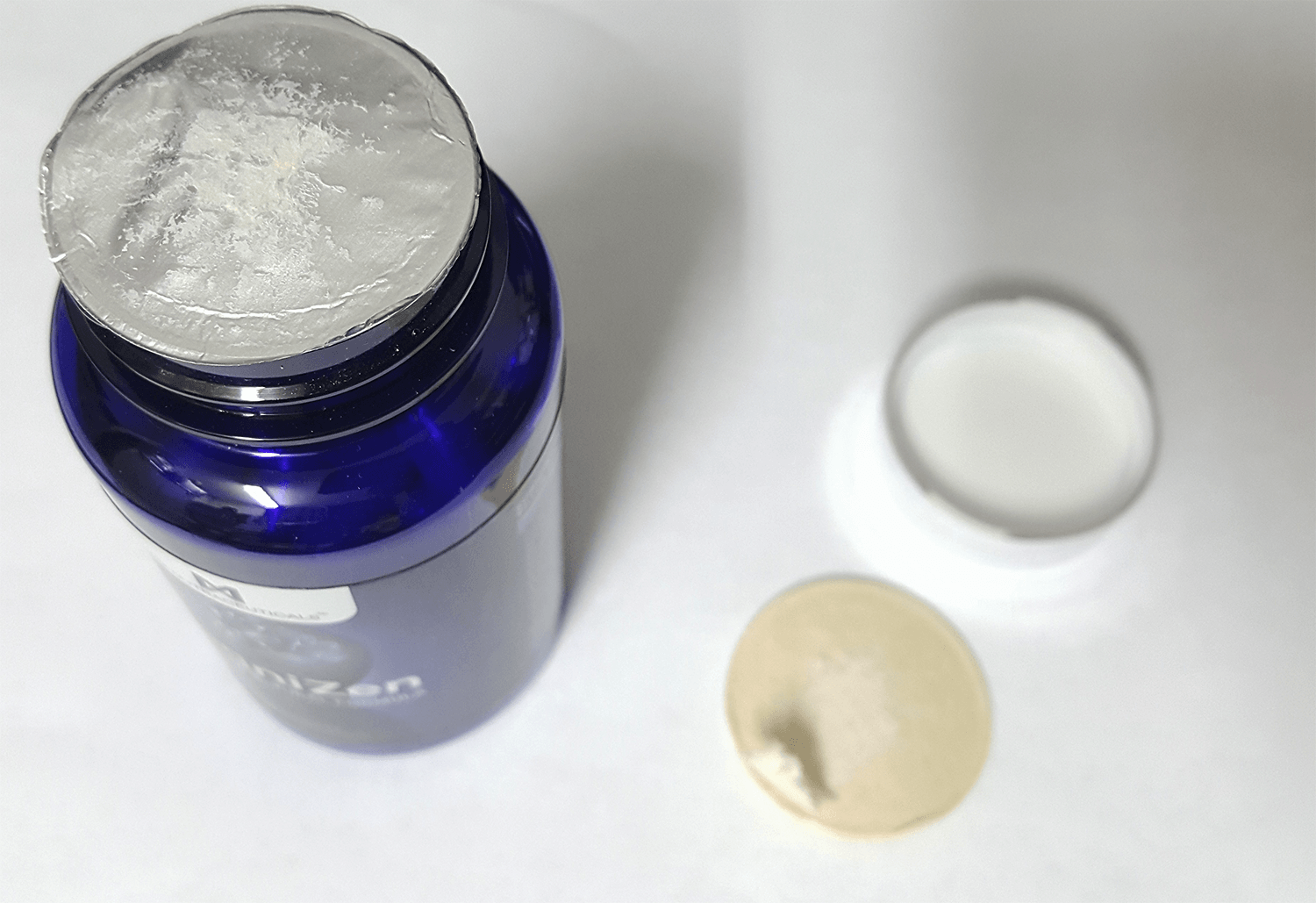
Moving onto the bottle itself, upon removing the seal I encountered yet another issue. The bottle looks dirty from the inside. Not dirty as in filthy, but dusty. There’s a lot of dust and given its color I’m assuming it’s capsule powder that has somehow leaked out.
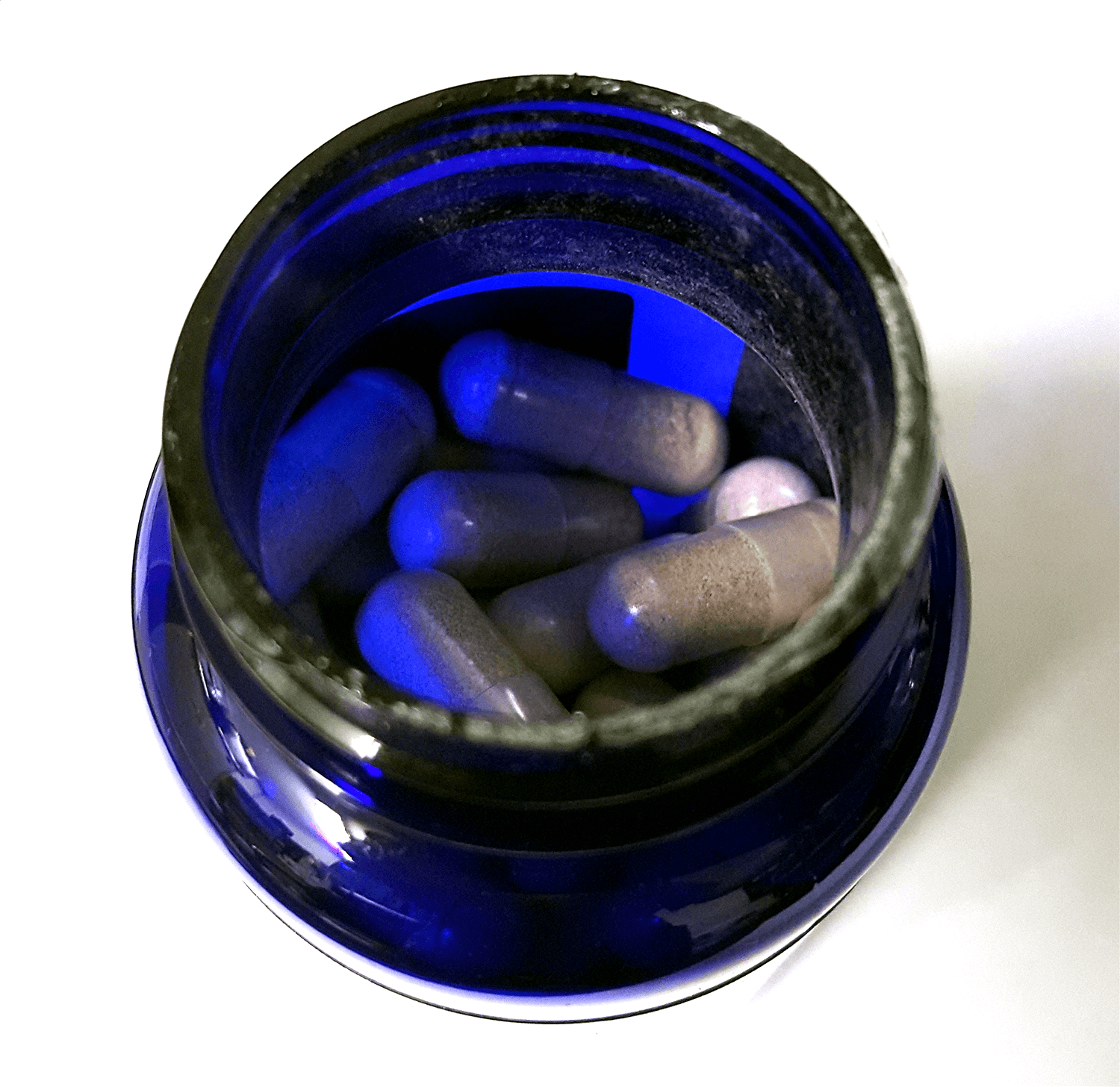
I swiped some off with my finger and it definitely does not feel like regular dust, but a combination of different nootropic powders. Again, this isn’t really a big deal.
However, given all these minor issues the packaging gives off a rather cheap quality feel. Summing it up:
- There’s no quick-access lid
- No outer plastic seal
- Poor bottle opening seal
- Dusty insides
Safety
Safety is one of the most important factors when it comes to nootropics or any supplement for that matter. I take safety very seriously. There’s no point in enhancing cognition if it comes at the price of health. For this reason, I always ask for certificates of analysis, also know as CoA.
I’ve received and checked the certificates from the founder of KogniZen. It appears everything is good. All the nootropics seem to conform to the target active dose, are free from heavy-metals as well as bacteria, and are >99% pure.
Ingredients
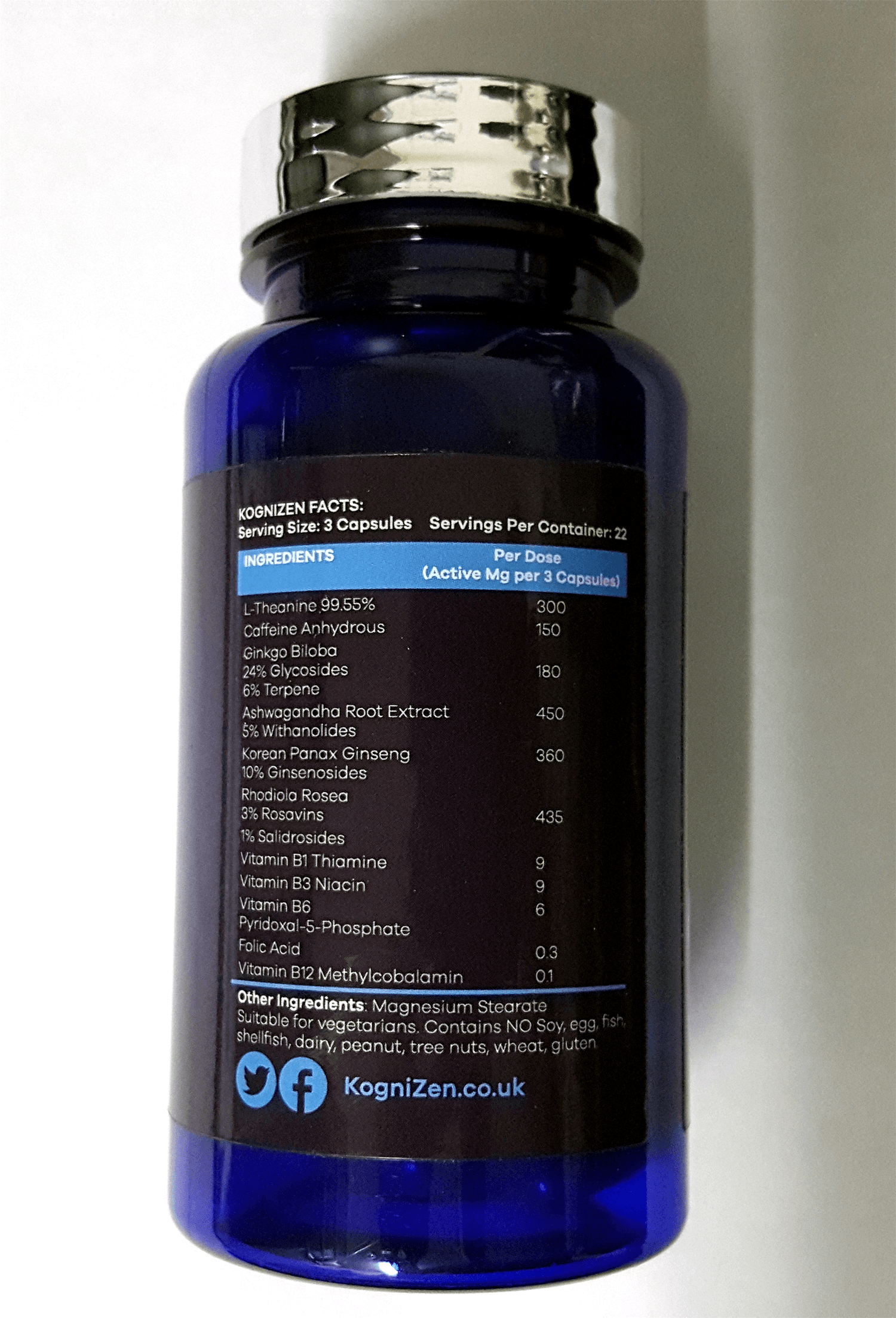
Aside from the nootropics, there’s only one other ingredient in this product:
- Magnesium stearate
This is an additive that acts as a flow agent. It prevents powders from sticking together and is generally regarded as being safe.
Aside from that, there doesn’t appear to be any information regarding the capsule itself. However, on the bottle it states that it’s “suitable for vegetarians. Contains no soy, egg, fish, shellfish, diary, peanut, tree nuts, wheat, gluten”.
The capsule is likely made from Hydroxypropyl Methylcellulose, a vegetarian source. These capsules are also known as Vcaps.
Capsule consistency
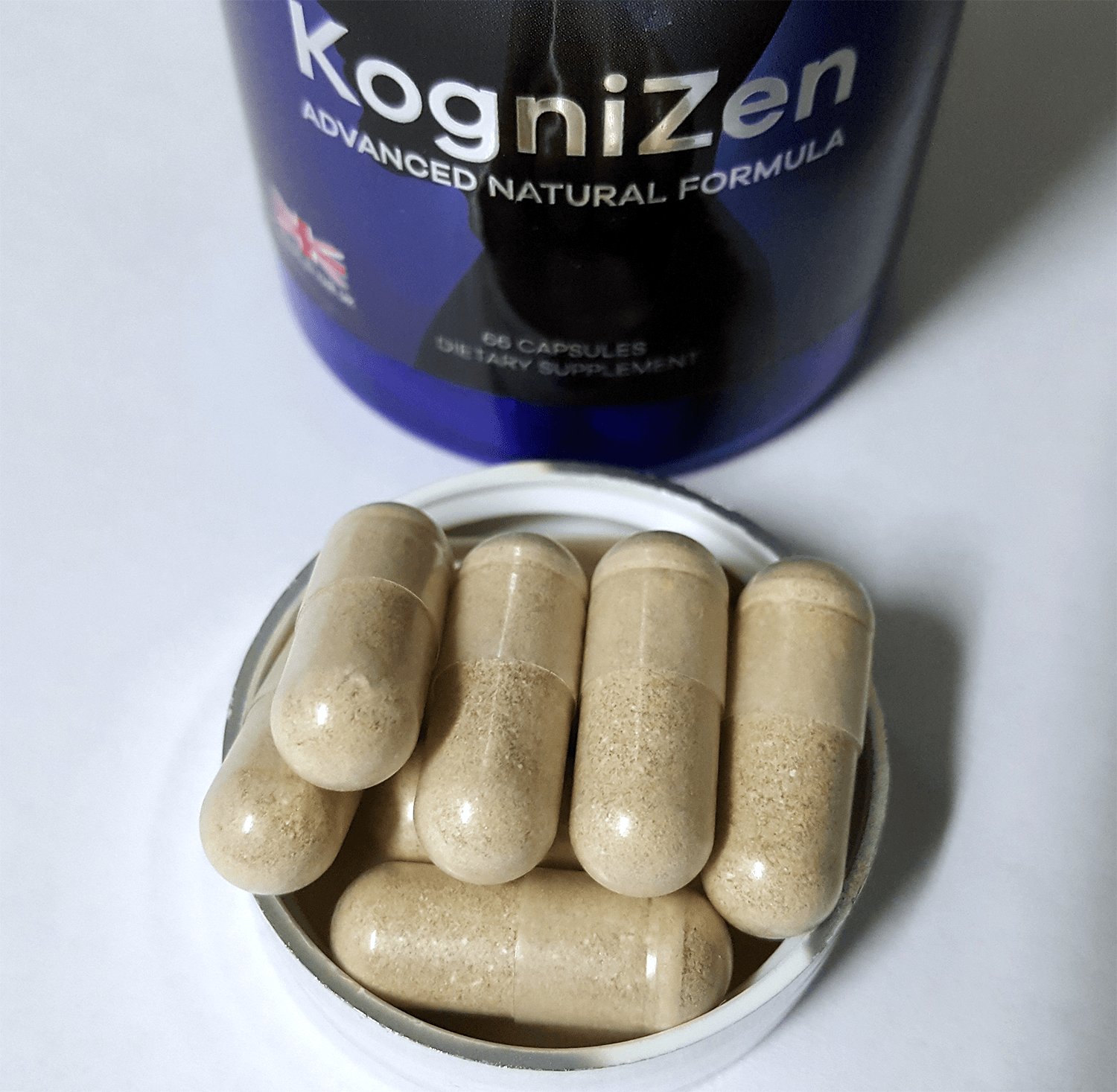
I tested the consistency of each capsule’s mass. I weighed 10 of them on my digital scale multiple times just so I can be confident in the readings.
Note that there’s an error-margin of about ± 50 mg. My digital scale isn’t the best.
- 780 mg
- 790 mg
- 770 mg
- 790 mg
- 760 mg
- 780 mg
- 770 mg
- 790 mg
- 790 mg
- 780 mg
Conclusion
KogniZen is a great nootropic formula that uses an impressive amount of synergistic nootropics. The nootropics hardly interact with one another as they all have very distinct mechanisms of action. It also includes b-vitamins that ensure neurotransmitter production is optimal, which directly helps with its effects as the nootropics all affect neurotransmitters in one way or another.
I found KogniZen to help greatly enhance my focus, but in a gentle and subtle way. This is in contrast to stimulants which forcibly improve my focus. The formula definitely elicits a relaxing and almost euphoric effect not only on the body but also mind. There’s a noticeable effect on mood and is quite strong. It not only uplifts mood but it also reduces the effects of unpleasant experiences thereby ensuring mood stays uplifted in a stable manner.
As with focus, energy is also improved. However, it also seems to reduce fatigue. A bit too well actually. It really made falling asleep much, much more difficult than normal and even when I did manage to fall asleep I’d wake up multiple times within an hour. It’s odd because I didn’t really feel energized, but rather not tired. It’s as though KogniZen blocks sleepiness.
Aside from that I didn’t notice any other side effects. So with the exception of sleep, its effects are quite good. However, the bottle isn’t the best. The aluminium seal on the bottle opening was loose and open in some areas. The insides of the bottle are filled with nootropic dust which detracts from its overall image.
All in all, KogniZen is a great nootropic product that can be used for any cognitively-demanding task.
| Summary of review | |
|---|---|
| Effects | |
| Packaging | |
| Ingredients and Safety | |
| Recommend? | Yes – An excellent nootropic formula that works well for all kinds of cognitively-demanding tasks |
| Overall Rating | |
| Visit KogniZen | |
References
- Kimura, Kenta, et al. “L-Theanine reduces psychological and physiological stress responses.” Biological psychology 74.1 (2007): 39-45.
- Mason, Russ. “200 mg of Zen: L-theanine boosts alpha waves, promotes alert relaxation.” Alternative & Complementary Therapies 7.2 (2001): 91-95.
- Owen, Gail N., et al. “The combined effects of L-theanine and caffeine on cognitive performance and mood.” Nutritional neuroscience 11.4 (2008): 193-198.
- Haskell, Crystal F., et al. “The effects of L-theanine, caffeine and their combination on cognition and mood.” Biological psychology 77.2 (2008): 113-122.
- Kelly, Simon P., et al. “L-theanine and caffeine in combination affect human cognition as evidenced by oscillatory alpha-band activity and attention task performance.” The Journal of nutrition 138.8 (2008): 1572S-1577S.
- Giesbrecht, Timo, et al. “The combination of L-theanine and caffeine improves cognitive performance and increases subjective alertness.” Nutritional neuroscience 13.6 (2010): 283-290.
- Kennedy, David O., Andrew B. Scholey, and Keith A. Wesnes. “The dose-dependent cognitive effects of acute administration of Ginkgo biloba to healthy young volunteers.” Psychopharmacology 151.4 (2000): 416-423.
- Tsuchida, Hiromi, and P. D. Tredici. “Hibaku trees of Hiroshima.” Arnoldia: The Magazine of the Arnold Arboretum 53 (1993): 25-9.
- Scholey, Andrew B., and David O. Kennedy. “Acute, dose‐dependent cognitive effects of Ginkgo biloba, Panax ginseng and their combination in healthy young volunteers: differential interactions with cognitive demand.” Human Psychopharmacology: Clinical and Experimental 17.1 (2002): 35-44.
- Wesnes, K. A., et al. “The memory enhancing effects of a Ginkgo biloba/Panax ginseng combination in healthy middle-aged volunteers.” Psychopharmacology 152.4 (2000): 353-361.
- Kennedy, David O., Andrew B. Scholey, and Keith A. Wesnes. “Modulation of cognition and mood following administration of single doses of Ginkgo biloba, ginseng, and a ginkgo/ginseng combination to healthy young adults.” Physiology & behavior 75.5 (2002): 739-751.
- Chandrasekhar, K., Jyoti Kapoor, and Sridhar Anishetty. “A prospective, randomized double-blind, placebo-controlled study of safety and efficacy of a high-concentration full-spectrum extract of ashwagandha root in reducing stress and anxiety in adults.” Indian journal of psychological medicine 34.3 (2012): 255.
- Auddy, Biswajit, Phd Jayaram Hazra, and Phd Achintya Mitra. “A Standardized Withania Somnifera Extract Significantly Reduces Stress-Related Parameters in Chronically Stressed Humans: A Double-Blind, Randomized, Placebo-Controlled Study.”
- do Vale, Sónia, et al. “The relationship between dehydroepiandrosterone (DHEA), working memory and distraction–a behavioral and electrophysiological approach.” PloS one 9.8 (2014): e104869.
- Reay, Jonathon L., David O. Kennedy, and Andrew B. Scholey. “Single doses of Panax ginseng (G115) reduce blood glucose levels and improve cognitive performance during sustained mental activity.” Journal of Psychopharmacology 19.4 (2005): 357-365.
- Kennedy, David O., and Andrew B. Scholey. “Ginseng: potential for the enhancement of cognitive performance and mood.” Pharmacology Biochemistry and Behavior 75.3 (2003): 687-700.
- Kennedy, D. O., A. B. Scholey, and K. A. Wesnes. “Dose dependent changes in cognitive performance and mood following acute administration of Ginseng to healthy young volunteers.” Nutritional Neuroscience 4.4 (2001): 295-310.
- Sünram-Lea, S. I., et al. “The effect of acute administration of 400 mg of Panax ginseng on cognitive performance and mood in healthy young volunteers.” Current Topics in Nutraceutical Research 3.1 (2005): 65-74.
- Sünram-Lea, S. I., et al. “The effect of acute administration of 400 mg of Panax ginseng on cognitive performance and mood in healthy young volunteers.” Current Topics in Nutraceutical Research 3.1 (2005): 65-74.
- Cropley, Mark, Adrian P. Banks, and Julia Boyle. “The effects of Rhodiola rosea L. extract on anxiety, stress, cognition and other mood symptoms.” Phytotherapy research 29.12 (2015): 1934-1939.
- Benton, David, Rebecca Griffiths, and Jurg Haller. “Thiamine supplementation mood and cognitive functioning.” Psychopharmacology 129.1 (1997): 66-71.
- Meador, K. J., et al. “Evidence for a central cholinergic effect of high‐dose thiamine.” Annals of Neurology: Official Journal of the American Neurological Association and the Child Neurology Society 34.5 (1993): 724-726.
- Vrecko, Karoline, et al. “NADH stimulates endogenous dopamine biosynthesis by enhancing the recycling of tetrahydrobiopterin in rat phaeochromocytoma cells.” Biochimica et Biophysica Acta (BBA)-Molecular Basis of Disease 1361.1 (1997): 59-65.
- Bernstein, Allan L. “Vitamin B6 in clinical neurology.” Annals of the New York Academy of Sciences 585.1 (1990): 250-260.
- Smith, A. David, Young-In Kim, and Helga Refsum. “Is folic acid good for everyone?.” The American journal of clinical nutrition 87.3 (2008): 517-533.
- Stahl, Stephen M. “Novel therapeutics for depression: L-methylfolate as a trimonoamine modulator and antidepressant-augmenting agent.” CNS spectrums 12.10 (2007): 739-744.
- Miller, A. L. “The methylation, neurotransmitter, and antioxidant connections between folate and depression.” Alternative medicine review: a journal of clinical therapeutic 13.3 (2008): 216.
- Stahl, Stephen M. “Brainstorms: L-Methylfolate: A Vitamin for Your Monoamines.” The Journal of clinical psychiatry 69.9 (2008): 1352-1353.
- Lieber, Charles S., and Lester Packer. “S-Adenosylmethionine: molecular, biological, and clinical aspects—an introduction.” The American journal of clinical nutrition 76.5 (2002): 1148S-1150S.
- Dierkes, Jutta, et al. “Supplementation with vitamin B12 decreases homocysteine and methylmalonic acid but also serum folate in patients with end-stage renal disease.” Metabolism-Clinical and Experimental 48.5 (1999): 631-635.

